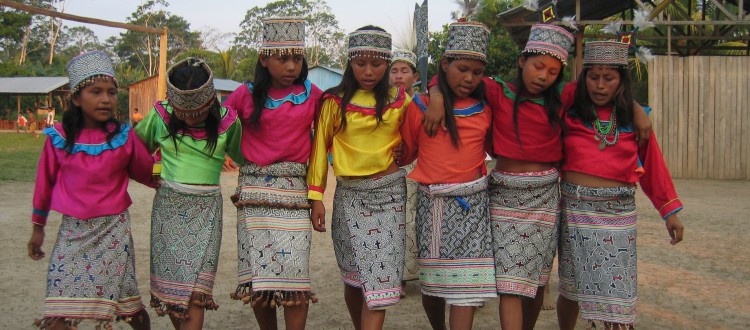On the eve of its address to the Oslo Tropical Forest Forum (OTFF), Peru’s national indigenous organisation, AIDESEP, has launched a joint report with the Forest Peoples Programme (FPP) which highlights the Peruvian government’s seeming inability to meet its progressive commitments to recognise indigenous peoples’ land rights. On a positive note, it documents rapid progress in the registration of indigenous lands thanks to decentralised funding programmes implemented and overseen by indigenous organisations.

In the words of Lizardo Cauper Pezo, President of AIDESEP, “Peru is one of the only countries in the world where, thanks to the struggle of indigenous organisations, climate funds are being invested directly in the recognition of indigenous territories. In practice however, change is slow and contradictory and these initiatives risk being undermined by bureaucratic obstacles. While the process of titling new territories is not fast enough, deforestation continues to advance.”
The report, titled: “A marathon not a sprint: The role of international climate finance in securing indigenous land rights in Peru”, tracks the status of commitments made by the Peruvian government since 2011 as part of its national climate mitigation strategy. These promises included reform of its outdated laws on indigenous land rights to align them with international human rights laws and to accelerate progress on the titling and demarcation of approximately 20 million hectares of indigenous lands and over 1300 communities whose recognition remained pending. In concrete terms the government committed to titling at least 5 million hectares of indigenous lands and earmarked at least $20 million worth of funding from international donors for the purpose. Donors include the Norwegian government, the UN Development Programme (UNDP) and the World Bank’s Forest Investment Programme (FIP).
The commitments responded to a welcome recognition from the Peruvian government that, and in line with increasing evidence from around the world, efforts to protect forests will only be equitable and effective if the land rights of indigenous and forest dependent communities are respected and recognised.
Despite this, the vast majority of these funds and projects have remained unimplemented in an apparent quagmire of red tape. The only real progress has been made by indigenous organisations themselves as direct recipients of the Forest Investment Programme’s Dedicated Grant Mechanism (FIP-DGM) for indigenous peoples which by the end of 2017 had resulted in the legal registration of 124 indigenous communities and the titling of 10 after just one year. To date, the sum total of indigenous peoples’ climate finance advocacy has resulted in the recognition of over 150 communities and the titling of 50.
Roberto Espinoza, co-author of the report, highlighted that “the experience of AIDESEP in Peru, having managed to ensure that the territorial rights of indigenous peoples were on the climate agenda and having redirected the investment of funds to that end, demonstrates that it is both possible and feasible to advance the objectives of territoriality and autonomy of indigenous peoples through participating in and influencing national and global climate processes. Nevertheless, progress is slow, with steps forward and backward and is in permanent conflict with the resistance and contradictions in the state and multilateral bureaucracies. That is why it continues to be a race of endurance, tenacity and persistence and one whose results take time to show. These results have now materialised and will continue to materialise. It is not a race of “speed” in which there are immediate results not is it neither ideal nor sufficient, because the “accumulation of lands through dispossession” is advancing rapidly. The important thing is the lessons that AIDESEP has left and its contribution to the international indigenous movement about how to reorient climate processes”.
Meanwhile, as the report outlines, the Peruvian government continues to favour a conservation model based on the creation of exclusive protected areas and the application of discriminatory and arbitrary criteria even when they do title indigenous peoples’ lands. These include the failure to recognise the full extent of indigenous peoples’ traditional lands while those “titles” that are issued are done so in the form of a “leasehold contract” which are not only precarious but extremely restrictive. To make matters worse, legal initiatives by indigenous organisations in the San Martin region to rectify these laws have been responded to with threats from the Peruvian government to cancel or suspend the land titling programme being implemented by the UNDP.
Worse still, despite the commitments made by the Peruvian government in 2008 to reduce net deforestation from an average of 123,000ha per year to zero by 2020 annual rates of deforestation have continued to increase year after year to over 160,000ha per year in 2016. In 2014 another joint report by AIDESEP and FPP highlighted how deforestation in the Peruvian amazon was spiralling out of control as a result of contradictory government policies favouring extractive industries and infrastructure projects aggravated by weak enforcement and environmental regulation alongside the existence of legal loopholes and perverse incentives that promoted deforestation.
Finally the report calls on the Peruvian government and the backers of its national climate strategy to significantly ramp up efforts to secure indigenous peoples’ lands and fulfil its legal obligations.
Dr Conrad Feather, co-author of the report explained: “The Inter American Court of Human rights has repeatedly established that States must safeguard indigenous lands and create no concessions or private holdings until the land rights of indigenous peoples in the area have been resolved. The Peruvian government claims it is too expensive and complicated to title indigenous peoples’ lands but they are the ones designing the onerous and complex procedures.
“If they really wanted to comply with the law and safeguard indigenous lands they could even do this without millions of dollars’ worth of funds. They could simply register indigenous land claims that have been filed and prevent any land allocations in the vicinity until the titling of that community had been resolved. They do this with the protected areas they create so why can’t they do this with indigenous territories?”
